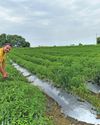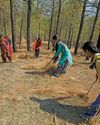
ON JUNE 15, the Jakhau port in Gujarat was hit by cyclone Biparjoy, which originated in the Arabian Sea about nine days prior. After two days of heavy rainfall, 234 cattle died and 47 people were injured, Union Home Minister Amit Shah told media persons while on a visit to cyclone-affected areas. The government evacuated more than 40,000 people amid devastation in the Kutch-Saurashtra region.
The cyclone's movement defied several early trajectory models such as that of the European Centre for Medium-Range Weather Forecasts, which initially predicted Biparjoy's path to Gujarat and Pakistan. Another weather model by the Global Forecast System of the US National Oceanic and Atmospheric Administration (NOAA) had predicted the cyclone's landfall to be in Oman. However, as it made landfall, the India Meteorological Department (IMD) was able to forecast its path to Gujarat and then Rajasthan, where it led to flood-like situations in multiple districts. As of June 20, Biparjoy has moved over Delhi-National Capital Region, and is now officially the longest-lived cyclone in the Arabian Sea basin.
But this is not the only notable aspect of the cyclone. Rather, it is the fact that Biparjoy's formation and intensification was aided by warmer ocean waters.
Esta historia es de la edición July 01, 2023 de Down To Earth.
Comience su prueba gratuita de Magzter GOLD de 7 días para acceder a miles de historias premium seleccionadas y a más de 9,000 revistas y periódicos.
Ya eres suscriptor ? Conectar
Esta historia es de la edición July 01, 2023 de Down To Earth.
Comience su prueba gratuita de Magzter GOLD de 7 días para acceder a miles de historias premium seleccionadas y a más de 9,000 revistas y periódicos.
Ya eres suscriptor? Conectar

THE CIRCULARITY ARGUMENT
A circular economy can help India achieve its developmental aspirations while following the low-carbon pathway. It will also help address the challenges of waste management, pollution and overexploitation of natural resources. Industries are already innovating to reuse high-volume wastes and have shown that the transition can usher in both environmental and financial windfalls

Banking on flawed drug voluntary licences
The Medicines Patent Pool is pushing for more VLs, but its bad deal with Novartis on a cancer drug shows the pitfalls

Lasting solutions
For the first time, the UN has recognised the role of indigenous communities in tackling aridity. A repository of traditional knowledge India has the wherewithal to lead the way

IMD at 150
India's journey into modern weather forecasting took a decisive turn 150 years ago with the establishment of India Meteorological Department during the British rule. The agency has come a long way since then, shaping the way the country predicts and responds to its diverse climate challenges

Every drop counts
In drought-prone Marathwada region, 14 villages have managed to counter water shortage by budgeting the resource

Threat to survival
Hollongapar Gibbon Sanctuary in Assam faces ecological challenges as railway electrification and hydrocarbon exploration endanger its fragile biodiversity

'Migration is going to be a battlefield'
AMITAV GHOSH is one of the foremost chroniclers of our times. His literary sojourn includes writings on topics that range from languages to climate change to human lives. His latest book, Wild Fictions, brings some of his works on these issues under one title. In a conversation with RAJAT GHAI, Ghosh shares his views on the future of human movement. Excerpts:

Face of future
California wildfires confirm forest fires are intensifying in a hotter world, emitting substantial amounts of greenhouse gases and reinforcing global warming

Friends of the forest
Residents of 30 villages in Uttarakhand establish a model for public participation in saving forests from wildfires

Climate-crazy playbook
Just hours after his second (and final) term began on January 20, US President Donald Trump unleashed 46 presidential actions. Several of these are centred on the US' climate commitments, energy transition, migration and trade policies, and are likely to have negative global implications